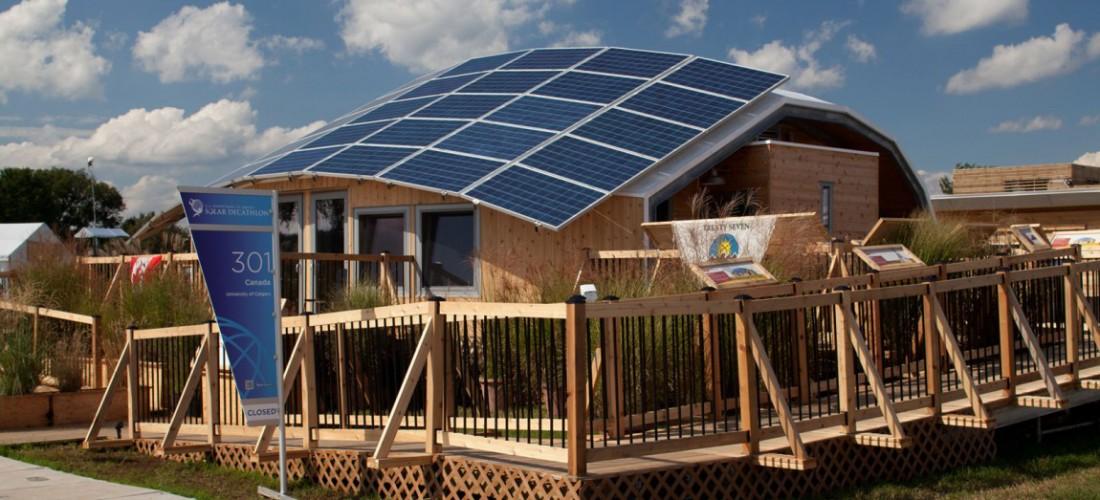
Technological Residence, Traditional Living (TRTL) or Cenovus Spo’pi Solar House, Canada's entry for the U.S. Department of Energy Solar Decathlon 2011, is a unique response to the culture of Treaty 7 Native Peoples in Southern Alberta. Inspired by the tipi, the house's rounded form, east-facing entrance, and south-facing windows relate to the sun as a traditional source of energy and life. (Credit: HomeDSGN.com)
A Cenovus Spo’pi Solar House, built at the University of Calgary for the Solar Decathlon, a biennial competition run by the U.S. Department of Energy, has now become a permanent research facility. University students designed and built this dome-shaped, 93 m2 (1001 square feet) structure that features the latest in solar power technology. An array of 37 photovoltaic panels on the roof generates enough electricity for a typical family of four to cook, do laundry, shower and operate household appliances for an entire year.
The house is net-zero, which means it produces as much electricity as it consumes. The only Canadian entry in the U.S. Department of Energy’s 2011 Solar Decathlon competition in Washington, D.C., the Cenovus Spo’pi Solar House placed 10th out of 19 entries. The house will now serve as a hub for solar energy and sustainability research for students and faculty members, including David Wood, Enmax-NSERC Industrial Research Chair in Renewable Energy.
This interdisciplinary project involved students from several areas of the University of Calgary, including the Faculty of Environmental Design, the Schulich School of Engineering and the Haskayne School of Business.
“This was a multi-disciplinary project where students from different fields of study worked together, and with members of our Aboriginal communities,” said Dru Marshall, provost and vice-president (academic). “The Cenovus Spo’pi Solar House will provide another means for the University of Calgary to contribute to and work with the community through research, teaching and service. I would like to thank Cenovus Energy for the generous sponsorship that made this possible.”
Cenovus Energy was the lead sponsor of the project, which is among several initiatives across campus in which the company has invested. Since 2009, Cenovus Energy has supported the Schulich School of Engineering, Faculty of Law, Faculty of Environmental Design, Institute for Sustainable Energy, Environment and Economy (ISEEE) and the Native Centre to enrich student programs and support research.
“Cenovus believes in supporting efficiency and innovation through education,” said Vicki Reid, Cenovus Director, Community Affairs. “A research facility of this nature speaks volumes to the importance of young innovators taking a creative approach to finding vital solutions to real-world energy and housing issues. We recognize that as world energy demand rises we must come up with creative solutions to meet those needs.”
Spo’pi is the Blackfoot word meaning “lives on stilts.” The home was built to address the housing needs of First Nations Communities. In order to be practical yet true to cultural beliefs and values, members of the Aboriginal community were consulted during design and construction. Guests at today’s celebration included a traditional drum group along with members of the Aboriginal Advisory Committee and the Treaty 7 region.
“Accommodating another culture’s values and principles in a project like Spo’pi allows us as First Nations to put value into our homes,” said Reg Crowshoe, spiritual and cultural advisor for the Piikuni First Nation. “I’m honoured to see our cultural beliefs reflected in the home that’s on this site.”
During an Indigenous groundbreaking ceremony last summer, Crowshoe gave a special blessing of the site on which the home was built. In the months since then, the house was reconstructed, furnished and connected to the campus utilities grid. A more formal Pipe Ceremony was held upon completion of the construction to transfer the stewardship of the solar house to the Schulich School of Engineering. This began a new chapter for the home as a high-tech, community- based teaching and learning facility on campus.
In addition to being used for research, the Cenovus Spo’pi Solar House will help the current Solar Decathlon team prepare for the 2013 competition by providing hands-on learning opportunities to test the efficiency of mechanical and solar systems to help plan future solar house projects.
Editor’s note: Recently, we also wrote about Stanford University’s and Chalmers University of Technology’s entrants in the Solar Decathlon competition.

